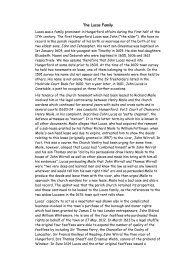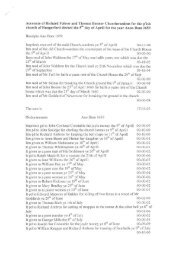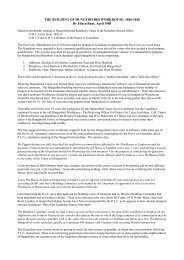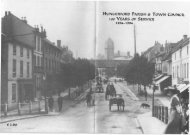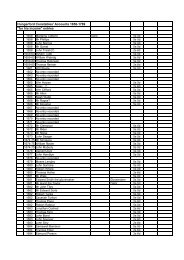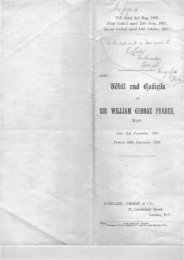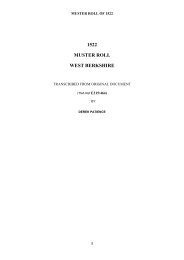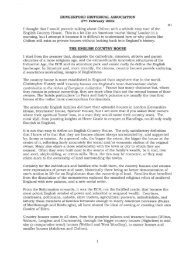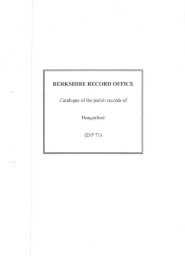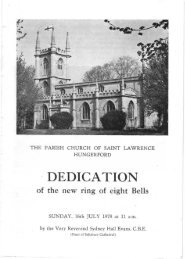fflSTORY OF - Hungerford Virtual Museum
fflSTORY OF - Hungerford Virtual Museum
fflSTORY OF - Hungerford Virtual Museum
You also want an ePaper? Increase the reach of your titles
YUMPU automatically turns print PDFs into web optimized ePapers that Google loves.
<strong>fflSTORY</strong><br />
<strong>OF</strong><br />
HUNGERFORD<br />
POLICE<br />
MAY 2001
(<br />
The Police Station in Park Street, <strong>Hungerford</strong><br />
has been in existence for over 130 years. The<br />
station was built in 1864 and originally consisted<br />
of a station office, two cells and living quarters<br />
for the officer in charge. The exterior of the<br />
building has changed little over the years<br />
although various interior alterations have been<br />
made in line with the needs of our ever changing<br />
system of policing.<br />
Berkshire Constabulary was formed in 1856 and<br />
the first Chief Constable was Col. Fraser, whose<br />
previous post had been as the Governor of the<br />
Middlesex House of Correction.<br />
<strong>Hungerford</strong> was part-of the South Western<br />
District under the control of Superintendent<br />
Dowde at Newbury and the first recorded<br />
officer in charge at <strong>Hungerford</strong> was Sergeant<br />
John Barnes. In addition the local area had a<br />
constable stationed in the villages of Kintbury,<br />
Wickham, Peasemore, Inkpen, Boxford,<br />
Shefford, Chaddleworth, Great Fawley and<br />
Lambourn.<br />
The pay scales for officers at this time were:
Sergeants - 23 shillings and Constables 17-21 shillings per week.<br />
In 18156 the Chief Constable issued the following instruction<br />
relation to prisoners.<br />
The expense of conveying prisoners by rail is to be avoided as<br />
much as possible. Where practicable they should be conveyed<br />
by cart the whole distances and when this cannot be effected<br />
they should be marched and passed on from post to post.<br />
» .»<br />
In 1859 the Faringdon and <strong>Hungerford</strong> Board of Guardians<br />
t<br />
appointed certain police officers as Assistant Relieving Officers<br />
to deal with the ever increasing problems in the area of tramps<br />
and vagrants. Several years later records show that in one year<br />
the <strong>Hungerford</strong> area dealt with 1,328 tramps.<br />
It is interesting to note that police officers at this time were<br />
permitted, in addition to carrying a staff and handcuffs, to carry<br />
a small cutlass at certain times "A small cutlass may be<br />
supplied to any Constable whose beat is so situated that in the<br />
in<br />
opinion of the two Justices of the County it is necessary for his<br />
personal protection in the performance of his duty.<br />
The cutlass<br />
is only to be worn at night or at times when rioting or serious<br />
public disturbance has actually taken place or is apprehended".<br />
The cutlass remained in being until 1902, when they had all to be<br />
handed in.<br />
It was on the night of 11 December 1876 that two police officers<br />
of the <strong>Hungerford</strong> area were murdered whilst on duty.<br />
The<br />
murders took place at Folly Crossroads on the A338 Wantage<br />
Road, just north of <strong>Hungerford</strong>. Inspector Joseph Drewitt had<br />
* 4 .<br />
set out from <strong>Hungerford</strong> on foot to meet up with PC Thomas<br />
Shorter from Shefford at the turnpike near the crossroads.<br />
Shortly after 10pm another officer, PC Golby set out to meet the<br />
Inspector, and on nearing the crossroads came across the battered<br />
body of PC Shorter.<br />
He ran back to raise the alarm and then<br />
after a further search:the body of the Inspector was found just to<br />
the east of the crossroads. He had been battered and shot in the<br />
neck at close range.<br />
Four local men, all notorious poachers<br />
were arrested by the following morning. At a subsequent trial at<br />
Berkshire Assizes two brothers, Francis and Henry Tidbury were<br />
found guilty of murder and hanged at Reading Prison.<br />
Two<br />
memorial crosses still mark the spots where the officers died at<br />
Folly Crossroads.<br />
In 1879 one officer recorded a typical days duty as working 7am<br />
to 1pm and 7pm to llpm and walked a distance of 14 miles.<br />
The following days duty was recorded at 6.30am to Sam and<br />
1pm to 10pm.<br />
y<br />
In 1889 the Chief Constable issued an order that he expected all<br />
*<br />
officers to attend some place of worship once on each Sunday,<br />
duty permitting, "as it should be remembered that ampngst a<br />
rural population the Constabulary exerts a great influence by<br />
setting a good example".<br />
In 1910 officers at <strong>Hungerford</strong> had to go to the assistance of their<br />
colleagues at Lambourn when on the night of an election poll for<br />
south Berkshire several local persons set fire to a wagon loaded<br />
1,000 people present in the market square when an effigy of a<br />
prominent minister of state was placed in the burning inferno.<br />
* In 1919 the officers hours of duty were reduced from 9 hours per<br />
i day to 3 hours per day and 5 hours by night.<br />
On the night of 17 March 1923 officers of the <strong>Hungerford</strong><br />
Section were faced with a daring burglary when thieves broke<br />
into Benham Park and stole a number of Gainsborough "Old<br />
Masters" by cutting them from their frames. Subsequently the<br />
-4<br />
paintings were traced "to London and four people were arrested.<br />
The ring leader, who was said to be "The worlds most daring<br />
cracksman" was gaoled for eight years.<br />
During the Second World War it is recorded that officers of the<br />
<strong>Hungerford</strong> area dealt with a crashed German bomber, when a<br />
junkers plane crashed on 1 November 1943 at Coombe Hill.<br />
Several officers from the area also assisted the Southampton<br />
*<br />
Police during air raids on the city.<br />
with wood and straw and covered in tar.<br />
There were about
1 April 1968 saw the amalgamation of tue Berkshire<br />
Constabulary into Thames Valley Constabulary (subsequently<br />
renamed Thames Valley Police). <strong>Hungerford</strong> Police continued to<br />
be part of the Newbury Police Division and patrols covered<br />
basically the same area that they had done for over 100 years.<br />
On the afternoon of 19 August 1987 PC Roger Brereton was<br />
murdered on duty in <strong>Hungerford</strong>. Although at the time he was<br />
working as a traffic patrol officer, he had recently been stationed<br />
at <strong>Hungerford</strong> and knew the area well. He was answering a call<br />
in Hungcrford or indeed the country. A memoriaJ plaque for<br />
Roger Brereton is hung in the foyer of the Police Station.<br />
In 1987 the interior of the police station was cdmpletely redesigned.<br />
The old cell, which had not been used for many years<br />
was removed and the public entrance area was completely redesigned.<br />
In the foyer is a scale matchstick model of the police<br />
station. This was made by a local man, Mr Billy Cox, who has<br />
permitted us to display it on the premises.<br />
to investigate a man seen^ walking up Southview with a gun and<br />
on turning into Southview to investigate he was shot dead in his<br />
car by Michael Ryan, who in total murdered 16 people on that<br />
day. All but one of the victims were killed by Ryan in the town.<br />
The first victim being shot in the Savernake Forest.<br />
„ After<br />
rampaging round the south end of the town he went to ground in<br />
»<br />
the John O'Gaunt School. The school was surrounded by armed<br />
police and in the early evening Michael Ryan shot himself, so<br />
• *<br />
bringing to an end the most tragic event that had ever happened
The station strength is now:<br />
1 Inspector<br />
2 Sergeants<br />
8 Constables<br />
(who make up The Community Policing Teams)<br />
1 Civilian Station Duty Officer<br />
1 part-time Traffic Warden<br />
The <strong>Hungerford</strong> and Downiands sector, as it is now known,<br />
is responsible for police coverage of not only the town of<br />
<strong>Hungerford</strong>, but covers the parishes of Lambourn, Great<br />
Shefford, East Garston, Chaddleworth, Boxford, Leckhamstead,<br />
Kintbury, Inkpen, Coombe, Hamstead Marshall, East and<br />
West Ilsley, Catmore, Peasemore, Winterbourne, Beedon,<br />
Chieveley, Hermitage, Fawley, Farnborough, Brightwalton,<br />
Welford and West Woodhay.<br />
In total this is an area of approximately 150 miles. The<br />
population of the area is now approximately 26,000.




